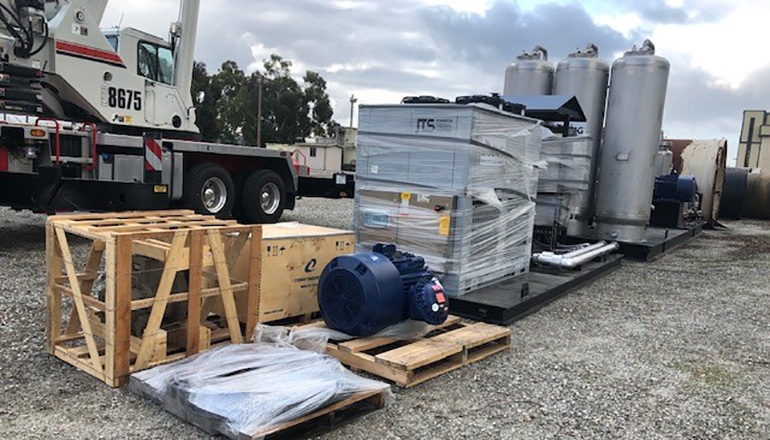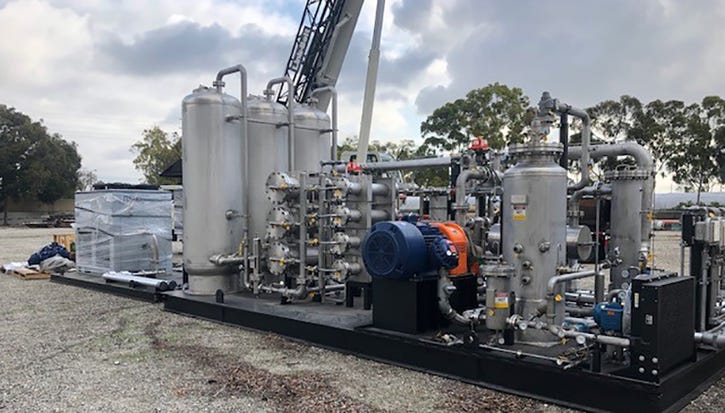The transportation fuel will be sold at Los Angeles County Sanitation Districts' CNG station and possibly injected into the pipeline.

In 2014, Los Angeles County Sanitation Districts (LACSD) saw the writing on the wall; SB 1383 requiring diversion of organics from landfill was not drafted yet but already the push was on to divert food from landfills. So, the agency began exploring what has since turned into a multimillion-dollar program to be able to co-digest food and biomass at its wastewater treatment plant. The end product will be transportation fuel it will sell at its public compressed natural gas (CNG) station and possibly inject into the pipeline.
“The project is currently under construction, and we anticipate pushing the start button in July of this year,” says Will Chen, supervising engineer, energy recovery engineering section of LACSD’s Solid Waste Department.
Partnering with Waste Management, the agency spent three years assessing the feasibility of using the existing anaerobic digestion operation at its wastewater treatment plant in Carson to co-digest food and sludge. They experimented at one of LACSD’s 24 anaerobic digesters to ensure parameters were acceptable such as pH, conductivity, total solids and contamination levels from inerts like plastics and glass.
The conclusion was that up to 62 tons of food waste could be handled per day.
“Enforcement of SB 1383 will be in two years, and haulers will primarily have two options for food waste: compost or anaerobic digestion. This project has enabled us to expand acceptance of these materials,” says Chen.

LACSD has invested in equipment and built a preprocessing plant at the materials recovery facility adjacent to the closed Puente Hills landfill in order to offer preprocessing to customers.
“We dedicated space on our tipping floor that allows haulers to tip food. Sorters remove contaminants, and we place food in a hopper that pushes it into a bio-separator. Water is added to make a slurry that’s pumped into trucks and transferred to the Joint Water Pollution Control plant in Carson,” says Habib Kharrat, division engineer of LACSD's solid waste operations and engineering section.
To date, LACSD has contracts with eight companies that bring food slurry to the wastewater treatment plant, which must pass slurry sample tests. Adherence to tight specs enables the material to be directly injected into the digester without going through the entire wastewater treatment process, which maximizes biogas production.
“We average about 30 tons a day of food waste that is turned into slurry at the Puente Hills facility. In total, counting slurry that comes from contracted haulers, the waste treatment plant receives 300 tons a day. Once the law has teeth in two years, we anticipate that volume will increase steadily. Los Angeles County alone generates 4,000 tons of food waste a day,” says Chen.
LACSD is spending $2.5 million on the biogas project that’s now in phase 1, which entails developing, designing and building a biogas conditioning system to clean the gas.
The conditioning system is being designed and built by Cornerstone Environmental Group, owned by Tetra Tech, based out of Pasadena.

“We selected equipment that’s used in over 20 locations around the U.S. It was relatively inexpensive and is effective at removing contaminants,” says Mike Michels, lead design engineer and executive vice president of Cornerstone Environmental Group.
What’s unique about this project, he says, is that the existing fueling station is adjacent to where the facility will be built.
Now, clean digester gas will come from this equipment rather than the pipeline it had come from previously.
“Key to making it work is cleaning the gas. It's also important to ensure that the pressure from the biogas delivered from the equipment is greater than the pressure of natural gas so it will flow through Clean Energy’s system with preference given to the digester gas. This ensures vehicle gas goes through from the digester rather than from the natural gas pipeline,” says Michels.
Phase 1 of the project will manage 400 standard cubic feet per minute of gas and produce 2,000 gasoline gallon equivalents per day. Phase 2 is being evaluated and will entail scaling up.
“We have a CNG station that can use RNG (renewable natural gas) now, and our intent is to feed that station 100 percent of our RNG. We are also evaluating pipeline injection and/or gas-to-energy,” says Chen, who explains that LACSD is now assessing its carbon intensity score, which determines the value of gas under California’s low carbon fuel standard (LCFS) credit program.
“For now, the station is open to the public with most of the vehicles being buses, trash trucks and passenger cars. In time, we intend to expand to accommodate large tractor trailers. With LCFS and RINs (renewable identification number), it makes sense. We should recover capital, and it should be a revenue-generating project to fund other food waste infrastructure projects,” says Chen.
About the Author(s)
You May Also Like




